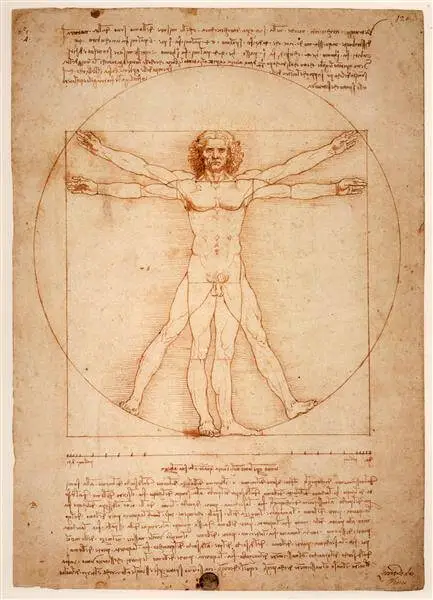Title of Artwork: “The Vitruvian Man (The proportions of the human figure)”


Artwork by Leonardo da Vinci
Year Created 1492
Summary of The proportions of the human figure (The Vitruvian Man)
The Vitruvian Man, also known as L’Uomo Vitruviano or simply The Vitruvian Man (Italian: Le proporzioni del corpo umano secondo Vitruvio, or “The proportions of the human body according to Vitruvius”), is a drawing by Leonardo da Vinci made around 1490.
It is accompanied by notes that are based on the architectural designs of Vitruvius. Drawing of a man in two superimposed positions with his arms and legs apart and inscribed in a circle and square.
Pen and ink on paper. The text and illustration are sometimes referred to as the Proportions of Man or, less frequently, the Canon of Proportions. Under reference 228, it is stored in the Gabinetto dei disegni e stampe of the Gallerie dell’Accademia in Venice, Italy.
It is not included in the museum’s regular exhibition because, like the majority of works on paper, it is only occasionally shown to the public.
All About The proportions of the human figure (The Vitruvian Man) by Leonardo da Vinci
The drawing is based on Vitruvius’ description of ideal human proportions in relation to geometry in Book III of his treatise De architectura. The human figure was cited by Vitruvius as the primary source of proportion in the classical orders of architecture. According to Vitruvius, the ideal body should be eight heads tall. The drawing by Leonardo is typically referred to as the architect’s drawing.
This picture shows how maths and art were combined during the Renaissance and how well-versed in proportion Leonardo was. Additionally, this image serves as a fulcrum in Leonardo’s efforts to connect man and nature.
According to the online version of Encyclopaedia Britannica, “Leonardo imagined the great picture chart of the human body he had created using his anatomical drawings and Vitruvian Man as a cosmografia del minor mondo (cosmography of the microcosm).” He thought that the functioning of the human body served as an analogy for the functioning of the universe.
It was created as an examination of the proportions of the (male) human body as they are described in Vitruvius, according to Leonardo’s preview in the accompanying text, which is written in mirror writing. Above and below the image, there are two sections of text.
According to the opening sentence of the upper section, “Vetruvio, architect, puts in his work on architecture that the measurements of man are distributed in nature in this way, that is:
and his buildings contain these measurements. The second sentence states that the navel will be the centre of the extended limbs and the space between the legs will be an equilateral triangle if you open your legs so much that your head is lowered by one-fourth of your height and raise your hands so much that your extended fingers touch the line of the top of your head.
These proportions are provided in the text’s lower section:
On the drawing, lines are drawn to indicate the points that determine these proportions. A single line, equal to a square side, divided into four cubits, the outer two of which are divided into six palms each, two of which have the mirror-text annotation “palmi,” and the outermost two of which are divided into four fingers each, are each annotated “diti,” appears beneath the drawing itself.






















